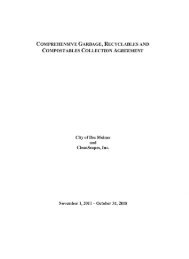CITY OF DES MOINES SHORELINE MASTER PROGRAM
CITY OF DES MOINES SHORELINE MASTER PROGRAM
CITY OF DES MOINES SHORELINE MASTER PROGRAM
Create successful ePaper yourself
Turn your PDF publications into a flip-book with our unique Google optimized e-Paper software.
Des Moines Shoreline Master Program<br />
except when a report confirms that there is a significant possibility that a primary structure<br />
will be damaged within three years as a result of shoreline erosion in the absence of such<br />
hard armoring measures, or where waiting until the need for armoring is so great that it<br />
would foreclose on the opportunity to utilize measures that avoid or minimize impacts to<br />
ecological functions. Where the geotechnical report confirms a need to prevent potential<br />
damage to a primary structure, but the need is not as immediate as the three years, that report<br />
may still be used to justify more immediate authorization to protect against erosion using soft<br />
shore stabilization measures.<br />
5. When any shoreline stabilization measures are demonstrated to be necessary, pursuant to<br />
above provisions, the City’s 2005 Shoreline Inventory and Characterization shall be used to<br />
assist in the implementation of the following additional standards:<br />
a. Limit the size of stabilization measures to the minimum necessary. Use measures<br />
designed to assure no net loss of shoreline ecological functions. Soft shore stabilization<br />
approaches that absorb and dissipate wave energy shall be used unless demonstrated not<br />
to be sufficient to protect primary structures, dwellings, and businesses.<br />
b. Ensure that publicly financed or subsidized shoreline erosion control measures do not<br />
restrict appropriate public access to the shoreline except where such access is determined<br />
to be infeasible because of incompatible uses, safety, security, or harm to ecological<br />
functions. When feasible, incorporate ecological restoration and public access<br />
improvements to the project.<br />
c. Mitigate new erosion control measures, including replacement structures, on feeder bluffs<br />
or other actions that affect beach sediment-producing areas to avoid and, if that is not<br />
possible, to minimize adverse impacts to natural sediment transport processes.<br />
d. All new or replacement shoreline stabilization and flood protection measures shall be<br />
designed and constructed so that down-current banks will not be adversely affected.<br />
Shoreline stabilization measures, including riprap, shall be designed and constructed in a<br />
manner consistent with the Department of Fish and Wildlife, Corps of Engineers and/or<br />
other engineering and design specifications deemed appropriate by the Shoreline<br />
Administrator.<br />
e. Bulkheads shall be permitted only where they provide protection to upland areas or<br />
facilities, not for the indirect purpose of creating land by filling behind the bulkhead.<br />
f. Adequate toe protection shall be provided to ensure bulkhead stability.<br />
g. Bulkheads shall be designed to permit the passage of surface or ground water without<br />
causing ponding or saturation.<br />
h. To receive permit approval for bulkhead construction, the applicant shall agree to grant<br />
adjacent property owners the right to tie in adjacent bulkheads.<br />
6. Shoreline vegetation shall be protected and restored along or near marine and freshwater<br />
shorelines to protect and restore the ecological functions and ecosystem-wide processes and<br />
to protect human safety and property.<br />
7. Cut-and-fill slopes and backfill areas shall be revegetated with native grasses, shrubs and/or<br />
trees.<br />
Department of Ecology approval effective November 1, 2010<br />
Adopted by City of Des Moines Ordinance No. 1502 71



